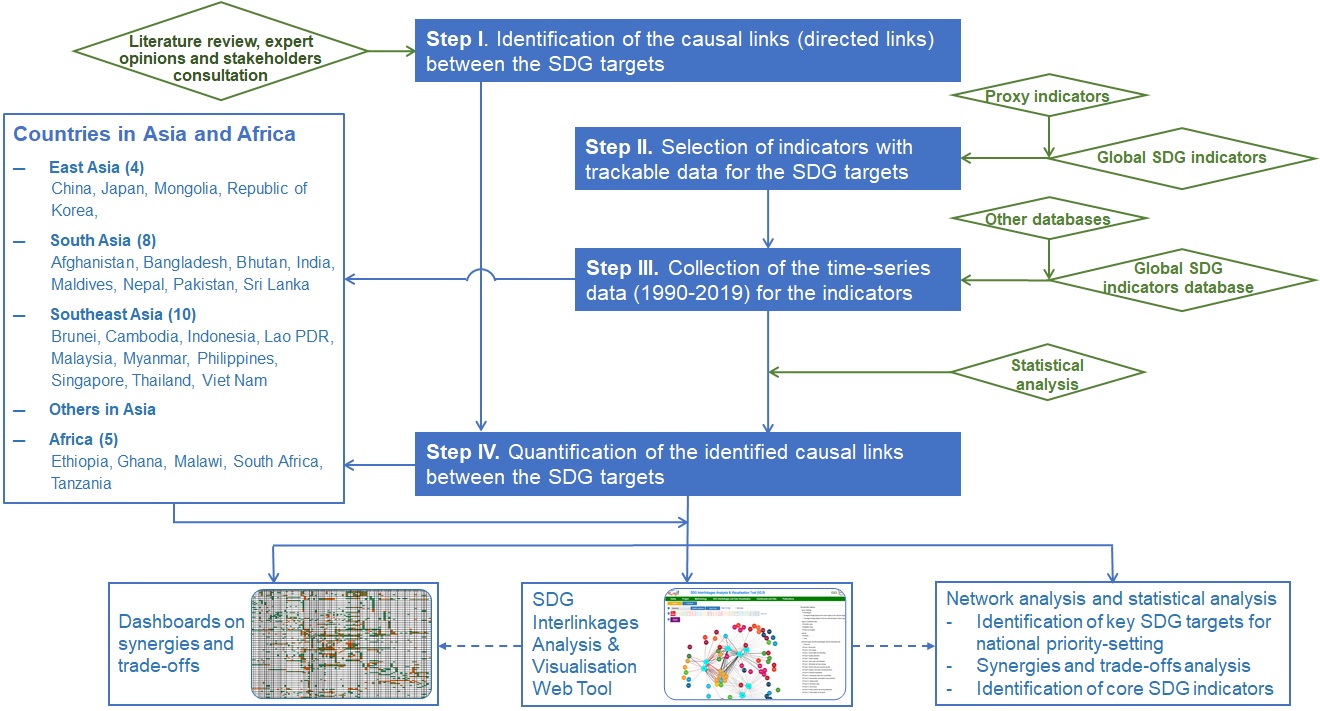Methodology
Adopted by the world leaders at the United Nations Sustainable Development Summit in September 2015, the 17 Sustainable Development Goals (SDGs) with 169 targets are guiding human development towards achieving the common future we want in 2030.
While the SDGs are broadly framed with 17 separate goals, they inherently interlink with each other forming an indivisible system with the three dimensions of social, economic and environmental. On the one hand, achieving one goal or target may contribute to achieving other goals or targets. For example, enhanced food security (Goal 2), full and productive employment and decent work (Goal 8) and reduction of inequalities (Goal 10) will help achieve poverty eradication (Goal 1). On the other hand, the pursuit of one goal or target may conflict with achieving others. For example, an increase in agricultural production to help end hunger and ensure food security (Goal 2) will increase water use in irrigation which may compete with the demand for universal access to drinking water (Goal 6).
Goals and their targets form a complicated network of interactions. Understanding the interlinkages among the goals and between the targets can help identify potential areas of synergies and trade-offs. Maximising the synergies and removing the trade-offs is a key feature of SDGs policy integration and coherence.
The importance of SDG integration has been recognised by many national governments which was reflected in the voluntary national reviews. Integrated policymaking requires a major shift from the conventional siloed approach to a systems approach. This is where the challenge lies, because there is neither sufficient knowledge on how the SDGs interact with each other, nor practical tools that can help identify and quantify the interlinkages between the targets. Some experts and institutions have initiated analysing SDG integration, but big gaps still remain, particularly in terms of the comprehensiveness (covering all the goals and targets), quantification of the SDG interlinkages, and the applications to practical case studies at the national and sub-national levels.
To address the existing knowledge gaps and build science-to-policy connections, IGES initiated a project on “SDG Interlinkages and Indicators,” under which a methodology with four steps to identify, quantify and visualise the SDG interlinkages was developed and applied to 27 countries in Asia and Africa. To enable relevant stakeholders to communicate on the potential synergies and trade-offs between the targets, IGES developed the SDG Interlinkages Analysis & Visualisation Tool, a web-based interface with free access.
The methodology includes four steps as follows:
- Step I: Identification of the causal links (directed links) between the SDG targets based on a comprehensive literature review
- Step II: Selection of indicators with trackable data for the SDG targets based on the Global SDG Indicators and other proxy indicators (e.g. the World Bank’s World Development Indicators)
- Step III. Collection of the time-series data (1990-2019) of the indicators for 27 countries in Asia and Africa
- Step IV. Quantification of the identified causal links between the targets (from Step I) based on a statistical analysis of the indicator-level time-series data

Methodology for the identification, quantification and visualisation of the SDG interlinkages
Source: Modified based on Zhou and Moinuddin (2017)󠄀
In terms of the scope of the SDG interlinkages, interlinkages can refer to those between goals, between a goal and relevant targets, or between targets. Interlinkages include direct relations between two targets or indirect relations that connect two targets via a third target or more intermediate ones. A causal link is a directed link which goes from the cause to the effect. Furthermore, interlinkages can be defined by causality or by other types of relations (e.g. social relations or a relay relationship, etc.). For the SDG Interlinkages Tool, the interlinkages between the targets are defined as direct causal links between the targets.
Identifying the causal links between relevant SDG targets is a challenging task due to the comprehensive scope covered by multiple disciplines. The causal links identified by the SDG Interlinkages Tool at the target level are based on a comprehensive literature review (see Zhou and Moinuddin, 2017). For a couple of case studies on specific topics (e.g. renewable energy and SDGs, SDGs at the river basin scale, sustainable consumption and production, SDGs localisation, urban-rural linkages, etc.), expert opinions and stakeholders consultation were conducted to help identify the interlinkages based on the context.
The identified causal links between the targets were further quantified to indicate how strong the links are and whether the links are positive or negative. Quantification is based on the correlation coefficients calculated from the indicator-level time-series data, indicating the linear relationship of the pair targets. Selection of the indicators for the targets was based on the Global SDG Indicators. When the global indicators or their data are not available, other proxy indicators, such as the World Bank’s World Development Indicators, were used (Click to see the correspondence table on the SDG goals, targets and selected indicators). The time-series data (1990-2019) of the indicators at the national level for 27 countries in Asia and Africa was collected from publicly available and internationally recognised sources. The UN Statistics Division’s SDG Indicators Global Database is the primary data source, and other data was collected from the databases provided by the World Bank or other UN or international organisations.
Pearson correlation coefficients, calculated from the time-series data, were used for the quantification of the identified causal links between the targets. The correlation coefficients, ranging from [-1, 1], indicate the linear relationship between the trend of relevant targets. Positive coefficients represent positive linear relations and negative ones indicate negative linear relations. Coefficients with larger absolute values (e.g., 0.9) indicate strong linear relationships and those with smaller absolute values (e.g. - 0.2) indicate weak linear relationships.
The SDG Interlinkages Tool will be updated on a regular basis to reflect the progress in the refinement of the global indicators, improvement in data availability and quality, and advancement in the knowledge of SDG interlinkages.